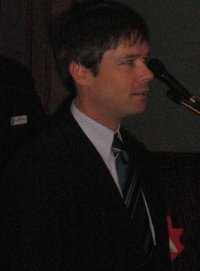
 Dr. Brian Horgan |
The decisions that golf course superintendents made last fall in regard to fertilization, nitrogen applications and coverings will determine the health and appearance of their turf in the spring. That was the principal message delivered by University of Minnesota turfgrass scientist Dr. Brian Horgan to Manitoba superintendents and students attending the Manitoba Golf and Turf Conference in Winnipeg, Nov. 23-25.
Horgan's topic was "recovery for northern climates." And that recovery, of course, depends on actions superintendents take in the fall. The proper time to apply water-soluble nitrogen fertilizer in the fall is after the last mowing, which is usually in mid-October when growth has essentially ceased, Horgan noted. Late fall fertilizer applications improve turf density and aid in carbohydrate accumulation as growth slows. The benefits are improved fall colour retention and earlier spring greenup. The optimum time to apple fertilizer in the fall is when the temperature is between five and 15 degrees Celsius, Horgan said. Nitrogen application rates for water-soluble sources are 0.5 to one pound of nitrogen per 1,000 square feet and, for organic and slow-release sources, one pound nitrogen per 1,000 square feet. |
Horgan asked how many in his audience had introduced nitrogen into their turf this past fall. Only three responded positively. He noted the reason so few put nitrogen into the plant at this time of year is because of the concern about snow mould developing.
"It is a dice roll," he observed about nitrogen input. "If you put it in at the wrong time, you risk encouraging disease. The key is experience. You have to know your pollens. Some pollens respond differently to different levels of nitrogen."
Nitrogen has to be applied at critical growth junctures, Horgan said. Different nitrogen sources have to be applied at different times. For IBDU, late fall application should be no later than Sept. 15. The cutoff time for natural organic nitrogen is October. The deadline for coated ureas is generally around Oct. 15. Soluble nitrogen can be held back until the beginning of November. Again, this is all weather dependent. A cool fall with early frosts may push these dates earlier.
"This year was tougher," he noted, "because there wasn't much time between the end of the warm weather and the beginning of cooler days."
Where ice is concerned, Horgan pointed out the danger to turfgrass can come during the initial ice formation at the beginning of winter or during thaws when standing water increases crown hydration levels and then there is a sudden drop in temperature below minus five degrees Celsius.
Poa annua turfgrass can survive up to 75 days under snow and ice, he noted. The hardier bentgrasses can survive up to 150 days under snow and ice.
Turf is most susceptible to injury as it starts to green again in March, he added. Crown hydration generally affects poa annua grass rather than bentgrass because the former is always ready to come out at the first hint of spring while the latter grows more slowly. However, given the right conditions, crown hydration can kill any turfgrass.
In discussing winter desiccation-death by drying out during the winter-Horgan noted that perennial ryegrass crowns are longer and more exposed than Kentucky bluegrass. The latter also contains rhizomes that protect growing points from winter desiccation.
In addressing the matter of covers to protect against winter desiccation, Horgan noted that permeable ones work well.
"We had guys in the Minnesota area who lost a lot of turf to winter kill because they put on impermeable covers over very wet soils. That resulted in a buildup of carbon dioxide and methane that proved lethal to the turf underneath. Now they are putting a foam layer down first and covering that with impermeable blankets."
He added that wood fibre blankets can also be used to protect against winter injury. The three to four-inch wood fibre keeps temperatures steady throughout the winter, he said. The disadvantages are that you need a barn to store them when not in use, and they have to be replaced every few years.
Print this page